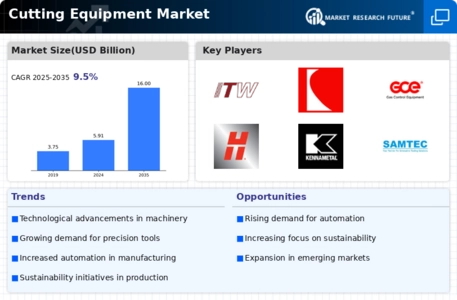Market Analysis
In-depth Analysis of Cutting Equipment Market Industry Landscape
The global cutting equipment market is set to reach US$ 10.2 BN by 2032, at a 9.50% CAGR between years 2023-2032. Supply, demand, and overall competition are influenced by a set of numerous factors that underlie the market dynamics. One key factor is technological developments that constantly improve the performance and accuracy of cutting implements. When manufacturers spend on research and development, new materials and advanced designs are developed demanding better cutting apparatuses. Secondly, the international economic environment is a key factor. Economic influences shape the dynamics of markets which invariably affect both industrial and consumer cutting tools spending. Another important consideration is the state of manufacturing industry as it determines in direct proportion demand for cutting machinery. Industrial applications such as automotive, aerospace and construction heavily depend on cutting tools for different works. This, therefore, means that movements in these industries have an impact on the cutting equipment market. Market players closely monitor these trends and make any necessary adjustments to their production as well as marketing plans. Market tendencies are also changed through globalization which creates new opportunities and challenges. The globalization of economies facilitates the spread for cutting equipment manufacturers, but it also increases competitive environment. Companies have to manoeuvre international trade policies, tariffs, and currencies as these can affect pricing positions impacting market share. In this complex international environment, collaboration and strategic partnerships become crucial for continued growth. The market is also affected greatly by regulatory changes. Cutting equipment design and manufacturing are influenced by environmental regulations, safety standards, quality certifications among other factors. Manufactures should be current on the latest regulation to adhere and keep its market standard. This continuously changing regulatory situation frequently results in an invention of eco-friendly and safer cutters. Market changes comes as a result of customer preferences and industry trends. Consumers tend to emphasize sustainable nature, safety, and cost effectiveness. As such, the competitive advantage lies in cutting equipment that fits with these preferences. The market is also influenced by industry dynamics that include the emergence of automation and smart manufacturing. The demand for interconnected and efficient production processes has also made cutting tools with integrated technologies, such as IoT sensors and data analytics. The raw materials prices, for instance metals and alloys used in cutting tools keeps changing the manufacturing cost directly. Such changes are followed closely by suppliers and manufacturers, who use them to make informed decisions on pricing as well as the allocation of resources. Raw material prices may become even more volatile due to unstable economic and geopolitical conditions, which affect the dynamics of markets. It is the distribution channels and e-commerce that have also contributed in defining cutting equipment market. In this way, online platforms give manufacturers alternative routes for interacting with customers and thus create disruption in conventional supply lines. This transition necessitates that companies alter their marketing and distribution techniques to maintain a competitive advantage in the rapidly digitalizing marketplace.










Leave a Comment